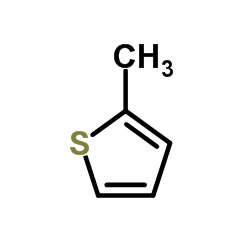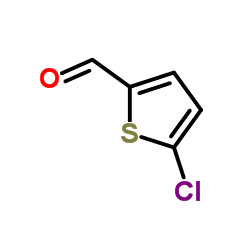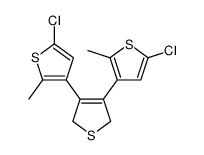17249-82-0
| Name | 2-Chloro-5-methylthiophene |
|---|---|
| Synonyms |
Thiophene, 2-chloro-5-methyl-
2-methyl-5-chlorothiophene 2-Chlor-5-methylthiophen 2-Chloro-5-methyl thiophene 2-Chlor-5-methyl-thiophen Thiophene,2-chloro-5-methyl 2-Chloro-5-methylthiophene MFCD01632145 5-chloro-2-methylthiophene 5-methyl-2-chlorothiophene 5-methylthiophen-2-yl chloride |
| Density | 1.2±0.1 g/cm3 |
|---|---|
| Boiling Point | 151.8±20.0 °C at 760 mmHg |
| Molecular Formula | C5H5ClS |
| Molecular Weight | 132.611 |
| Flash Point | 51.6±8.5 °C |
| Exact Mass | 131.980042 |
| PSA | 28.24000 |
| LogP | 3.00 |
| Vapour Pressure | 4.6±0.3 mmHg at 25°C |
| Index of Refraction | 1.554 |
|
Section I.Chemical Product and Company Identification Chemical Name 2-Chloro-5-methylthiophene Portland OR SynonymThiophene, 2-chloro-5-methyl- (CA INDEX NAME) Chemical FormulaC5H5ClS CAS Number17249-82-0 Section II.Composition and Information on Ingredients Toxicology Data Chemical NameCAS Number Percent (%)TLV/PEL 2-Chloro-5-methylthiophene17249-82-0 Min. 96.0 (GC) Not available.Not available. Section III. Hazards Identification Acute Health EffectsHarmful if ingested or inhaled. Minimize exposure to this material. Severe overexposure can result in injury or death. Irritating to eyes and skin on contact. Inhalation causes irritation of the lungs and respiratory system. Inflammation of the eye is characterized by redness, watering, and itching. Skin inflammation is characterized by itching, scaling, reddening, or, occasionally, blistering. Follow safe industrial hygiene practices and always wear proper protective equipment when handling this compound. Chronic Health EffectsCARCINOGENIC EFFECTS : Not available. MUTAGENIC EFFECTS : Not available. TERATOGENIC EFFECTS : Not available. DEVELOPMENTAL TOXICITY: Not available. Repeated or prolonged exposure to this compound is not known to aggravate existing medical conditions. Section IV.First Aid Measures Eye ContactCheck for and remove any contact lenses. In case of contact, immediately flush eyes with plenty of water for at least 15 minutes. Get medical attention. Skin ContactIn case of contact, immediately flush skin with plenty of water. Remove contaminated clothing and shoes. Wash clothing before reuse. Thoroughly clean shoes before reuse. Get medical attention. If the victim is not breathing, perform mouth-to-mouth resuscitation. Loosen tight clothing such as a collar, tie, belt or Inhalation waistband. If breathing is difficult, oxygen can be administered. Seek medical attention if respiration problems do not improve. INDUCE VOMITING by sticking finger in throat. Lower the head so that the vomit will not reenter the mouth and throat. Ingestion Loosen tight clothing such as a collar, tie, belt or waistband. If the victim is not breathing, perform mouth-to-mouth resuscitation. Examine the lips and mouth to ascertain whether the tissues are damaged, a possible indication that the toxic material was ingested; the absence of such signs, however, is not conclusive. Section V.Fire and Explosion Data Not available. Combustible.Auto-Ignition Flammability Flash PointsFlammable LimitsNot available. 47°C (116.6°F). These products are toxic carbon oxides (CO, CO2), halogenated compounds, sulfur oxides (SOx). Combustion Products WARNING: Highly toxic HCl gas is produced during combustion. Fire Hazards Not available. Risks of explosion of the product in presence of mechanical impact: Not available. Explosion Hazards Risks of explosion of the product in presence of static discharge: Not available. Fire Fighting Media Flammable liquid. SMALL FIRE: Use DRY chemical powder. and Instructions LARGE FIRE: Use alcohol foam, water spray or fog. Cool containing vessels with water jet in order to prevent pressure build-up, autoignition or explosion. Consult with local fire authorities before attempting large scale fire-fighting operations. Continued on Next Page 2-Chloro-5-methylthiophene Section VI.Accidental Release Measures Spill CleanupCombustible material. Harmful material. Irritating material. Keep away from heat. Mechanical exhaust required. Stop leak if without risk. Absorb with DRY earth, sand or other Instructions non-combustible material. DO NOT touch spilled material. Prevent entry into sewers, basements or confined areas; dike if needed. Consult federal, state, and/or local authorities for assistance on disposal. Section VII. Handling and Storage COMBUSTIBLE. HARMFUL. IRRITANT. Keep away from heat. Mechanical exhaust required. Avoid excessive heat and Handling and Storage light. Do not breathe gas/fumes/ vapor/spray. Information Always store away from incompatible compounds such as oxidizing agents. Section VIII. Exposure Controls/Personal Protection Provide exhaust ventilation or other engineering controls to keep the airborne concentrations of vapors below their respective Engineering Controls threshold limit value. Ensure that eyewash station and safety shower is proximal to the work-station location. Splash goggles. Lab coat. Vapor respirator. Boots. Gloves. Suggested protective clothing might not be sufficient; consult a Personal Protection specialist BEFORE handling this product. Be sure to use a MSHA/NIOSH approved respirator or equivalent. Exposure LimitsNot available. Section IX. Physical and Chemical Properties Liquid. (Clear, light yellow.)Solubility Physical state @ 20°CImmiscible with water. 1.21 (water=1) Specific Gravity Molecular Weight132.61Partition Coefficient Not available. Boiling Point155°C (311°F)Vapor PressureNot available. Not available.Not available. Melting PointVapor Density Refractive Index1.54VolatilityNot available. Not available.Not available. Critical TemperatureOdor ViscosityNot available.TasteNot available. Section X.Stability and Reactivity Data This material is stable if stored under proper conditions. (See Section VII for instructions) Stability Conditions of InstabilityAvoid excessive heat and light. Incompatibilities Reactive with oxidizing agents. Section XI. Toxicological Information Not available. RTECS Number Eye Contact. Ingestion. Inhalation. Routes of Exposure Not available. Toxicity Data Chronic Toxic EffectsCARCINOGENIC EFFECTS : Not available. MUTAGENIC EFFECTS : Not available. TERATOGENIC EFFECTS : Not available. DEVELOPMENTAL TOXICITY: Not available. Repeated or prolonged exposure to this compound is not known to aggravate existing medical conditions. Harmful if ingested or inhaled. Minimize exposure to this material. Severe overexposure can result in injury or death. Acute Toxic Effects Irritating to eyes and skin on contact. Inhalation causes irritation of the lungs and respiratory system. Inflammation of the eye is characterized by redness, watering, and itching. Skin inflammation is characterized by itching, scaling, reddening, or, occasionally, blistering. Follow safe industrial hygiene practices and always wear proper protective equipment when handling this compound. Section XII.Ecological Information Not available. Ecotoxicity Environmental FateNot available. Continued on Next Page 2-Chloro-5-methylthiophene Section XIII. Disposal Considerations Waste DisposalRecycle to process, if possible. Consult your local regional authorities. You may be able to dissolve or mix material with a combustible solvent and burn in a chemical incinerator equipped with an afterburner and scrubber system. Observe all federal, state and local regulations when disposing of the substance. Section XIV. Transport Information DOT ClassificationDOT CLASS 3: Flammable liquid. PIN Number Proper Shipping NameFlammable liquid, n.o.s. Packing Group (PG)III DOT Pictograms Section XV. Other Regulatory Information and Pictograms TSCA Chemical InventoryThis product is NOT on the EPA Toxic Substances Control Act (TSCA) inventory. The following notices are required by 40 CFR 720.36 (C) for those products not on the inventory list: (EPA) (i) These products are supplied solely for use in research and development by or under the supervision of a technically qualified individual as defined in 40 CFR 720.0 et sec. (ii) The health risks of these products have not been fully determined. Any information that is or becomes available will be supplied on an MSDS sheet. WHMIS ClassificationCLASS B-3: Combustible liquid with a flash point between 37.8°C (100°F) and 93.3°C (200°F). (Canada) EINECS Number (EEC)Not available. EEC Risk StatementsR10- Flammable. R18- In use, may form flammable/explosive vapor-air mixture. R20/21/22- Harmful by inhalation, in contact with skin and if swallowed. R36/37/38- Irritating to eyes, respiratory system and skin. SECTION 16 - ADDITIONAL INFORMATION N/A |
| Hazard Codes | F+ |
|---|---|
| Risk Phrases | 20/21/22-36/37/38 |
| Safety Phrases | S26-S36/37/39 |
| HS Code | 2934999090 |
|
~83% 
17249-82-0 |
| Literature: Lucas, Linda N.; De Jong, Jaap J. D.; Van Esch, Jan H.; Kellogg, Richard M.; Feringa, Ben L. European Journal of Organic Chemistry, 2003 , # 1 p. 155 - 166 |
|
~% 
17249-82-0 |
| Literature: Journal of Organic Chemistry, , vol. 14, p. 638,639 |
| Precursor 2 | |
|---|---|
| DownStream 5 | |
| HS Code | 2934999090 |
|---|---|
| Summary | 2934999090. other heterocyclic compounds. VAT:17.0%. Tax rebate rate:13.0%. . MFN tariff:6.5%. General tariff:20.0% |







![Hydrazinecarbothioamide,2-[(5-chloro-2-thienyl)methylene]- structure](https://image.chemsrc.com/caspic/009/6286-19-7.png)